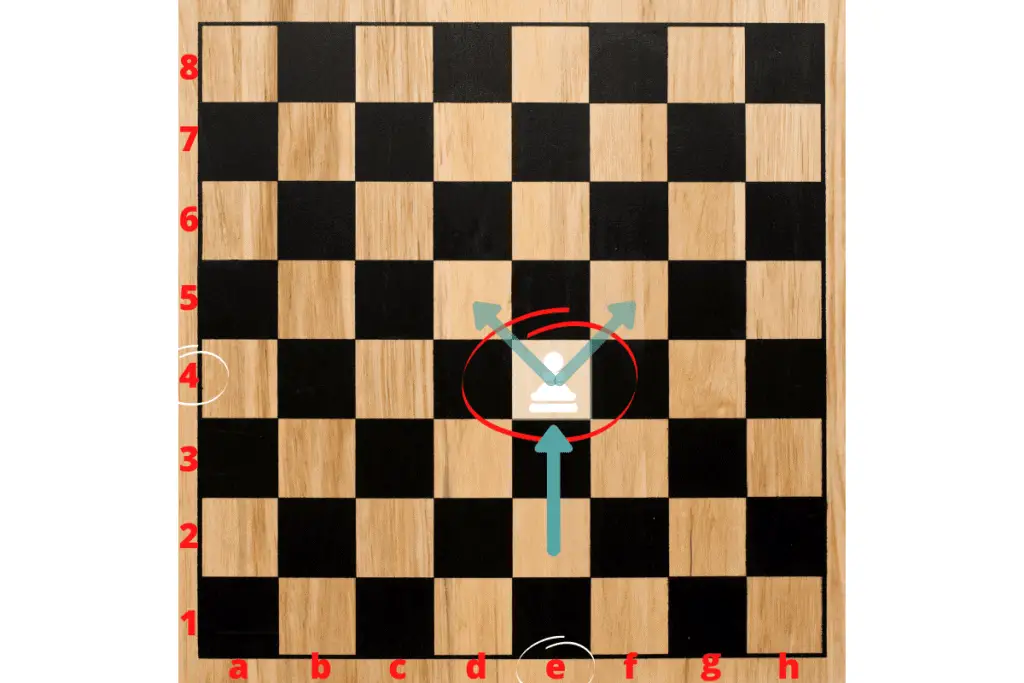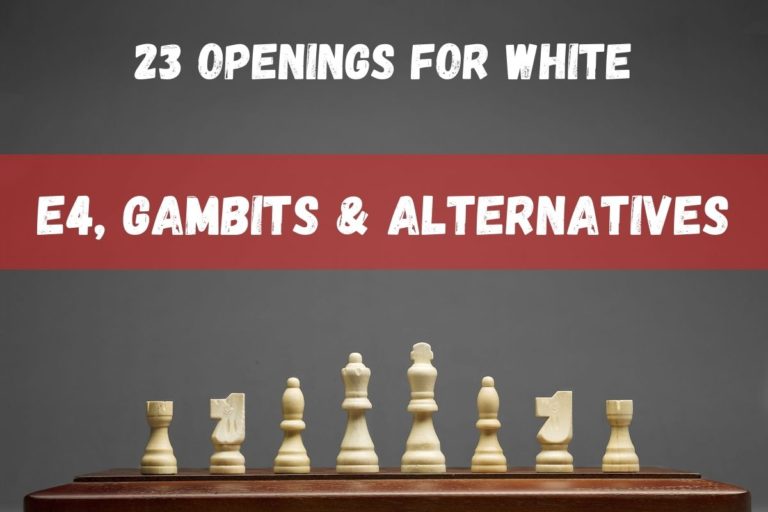6 Chess Openings for Beginners: Start Winning More Often
⭐⭐⭐ Take 7 minutes to read and improve your chess game ➡️ : This article was first published on, and is Copyright of Chessquestions.com
It is said chess games can be won or lost with an opening strategy in chess. So at beginner level, it is important not to get lost in opening theory study but to learn a few openings for both white and black pieces to be able to start on the right foot and recognize popular opening strategies that include traps so an early loss of advantage can be avoided. This post is going to highlight the best openings for beginners to learn first and the French Defence is included in my unbeatable chess strategy post.
Here are 6 chess openings all of which begin with the most common first move in chess, pawn to position e4
- Ruy Lopez/Spanish opening
- Giuco Piano
- Kings Gambit
- Sicilian Defense
- French Defense
- Caro-Kann Defense

As we know, white always goes first in a game of chess and by far the most common first move for white is the e4 opening. This is the first move of a whole range of openings for white and counters for black.
You will be introduced to white openings and black openings that strong players use, all based around White e4.
This guide is going to use chess notation, it is very easy to understand and quick to learn and refers to a grid of letters [files] and numbers [ranks] making up the 64 squares on a chess board.
What is a good Opening in Chess
It is considered a good opening strategy to get some pawn structure set up, particularly into the center of the board; your knights out in supporting the pawns or vice versa, and your king castled to safety. They are the general first moves of an opening with the overall goal to at best not lose by the advantage that white has from the start and take early control of the center of the chessboard with a solid position.
Best opening moves
1. White Pieces – 1. e4, 1.d4, 1. c4 or 1 Nf3
2. Black Pieces after e4 – Ruy Lopez, Sicilian Defense, French Defense, Caro-Kann
Chess Opening Tips for Beginners
- Don’t spend forever learning openings, select a few and learn them well
- Understand the idea behind the opening
- Practice what you learn by using them in real games
- Ruy Lopez, Giuco Piano and the Sicilian Defense are some of the best openings for beginners to start with.
Given that e4 is the most common first move, we will concentrate this guide for openings for beginners around the e4 first move and leads us onto this little list
If you are playing black and going second, this signifies an entire range of possibilities of openings you can play, so let’s take a look at these 7 chess openings for beginners from e4 in a little more detail. This will assist you in committing them to memory and learning how and when to play them without getting involved in complicated positions at this stage.
White pawn e4 first move – Why?
Playing first as white and moving your Kings pawn 2 square forward to e4 occupies one of the center squares and stakes a claim to both d5 and g5.
A favorite opening of many a master chess player, e4 creates a strong centerboard providing a space advantage and opening up a diagonal line for both the queen or the king’s bishop to move out. Immediately you have options to begin building a king side attack on the black king.
Anyway, let’s take a look at openings following e4, starting with arguably the most famous – The Spanish Opening best known as the Ruy Lopez and begin building your opening skills.
Ruy Lopez
Ruy Lopez begins with e4, and becomes the signature Ruy Lopez at the point the bishop stretches out to b5.
1 e4 e5 2. Nf3 Nc6 3. Bb5
The Ruy Lopez Opening was named after a 16th century clergyman with a passion and penchant for chess to a degree whereby he wrote a book all about chess openings, one of the first opening theory studies. Like many things [in chess and elsewhere] it was not his specific invention, but he became associated because of his recording of the move and the later discovery of his theories.
There were much earlier mentions of the move from as far back as 1490, but from there, it took some 350 years for the moves to be referred to as the Ruy Lopez as a chess theorist from Russia discovered Lopez’s recording and expanded upon its potential.
A favorite opening of many a master player, Ruy Lopez becomes the signature move once the king’s bishop moves to b5. It places pressure on the black knight and on a diagonal to the King.
This will be countered in most cases by a6, attacking the bishop which can move back to a4 – From there the opening has many possible twists and turns, and this video by the excellent Chess Openings & Strategies channel provides a wealth if information
Giuco Piano
One of the oldest Chess Openings Giuco Piano [pronounced ‘jioko piano’], is part of the Italian game beginning with the white pawn e4, mirrored Knight moves and then Bishops both coming to the left-hand side of the board. originating in the 16th century it has lost favor in recent times.
Moves: 1. e4 e5 2. Nf3 Nc6 3. Bc4 Bc5
The opening remains attacking with white grabbing a center square with e4, Black matches Kings pawn and white pushes kings knight out in traditional fashion after which the Kings bishop is also released for the Italian game and the kingside castle is available early.
Where the opening goes from there depends on the whites fourth move, which could be any of the continuations of Giuoco Piano main line with
- c3 Main Line
- The Evans Gambit b4 tempting the black knight or queens bishop with the hanging pawn
- or the Giuoco Pianissimo, the short d3 Queens pawn move
Playing this opening is good for chess beginners, as it opens up the board with good positions, and without playing the Evans Gambit doesn’t expose early weaknesses but opens Qb3 for backup to the bishop for the weak f7 square.
Kings Gambit
One of the most simple and quick openings in chess that gets its name for the fact that white makes a very quick pawn sacrifice on the kingside. If black doesn’t accept the gambit, white has a very quick capture for a rapid attack on the enemy king.
Moves: 1. e4 e5 2. f4
Developed and played when chess was all-out attack without the subtleties and strategies that have evolved over time, the king’s gambit sends out a clear message to the opponent of your intention.
The Key to the Kings Gambit is that you will be a pawn down from early on, but if you are comfortable with that and can develop the space in the centre, you may soon be trading up.
Sicilian Defense
You have probably hard of the Sicilian Defense, it is one of the most common openings to white starting position on e4. and replies with c5, preventing white from making d4 in addition to the open and occupying with double central pawns.
Moves: 1. e4 c5
The most popular response to the Sicilian defense, is Nf3, Nc3, or Be2 to which you will almost certainly reply with d6.
You often find white will play d4 to attack your c5 pawn, and now is the right time to take, when you’ll amots certainly have traded pawns as white plays Nxd4
This is where we are at in the demostration below
The pawn trade has opened up the c-file, the queens has options, ot the bishop and Knight can be developed, leaving a long castle. Right now, white’s queenside is open and this is where black will usually look to attack.
There are many different variations and line in the Sicilian Defense and it is popular because it is a solid opening. Anyone looking to learn beginner openings should investigate and thoroughly study the Sicilian defense and all it’s lines, as a superb opening when playing black pieces.
French Defense
We are back with the Black pieces for the French Defense. When white opens with e4, the French dictates a single square pawn move for black playing e6.
Moves: 1. e4 e6
Black now has both Kings bishop and queen open for diagonals, but also the queens bishop somewhat blocked. This is a weak area and should always be considered in whatever comes next.
You can expect white to play d4 and get double pawn occupation on the 4th rank to which you can reply with the normal variation of d5 offering a pawn trade and opening the e-file.
From here white will either bring the Knight into play on Nc3, or run the Queens bishop to g5 attacking your queen.
If white plays c3 and you reply with Nf6, we have a game that is likely to be be a fast paced attempt to strike first on opposing side of the board and gain positional advantages.
Second only to the Sicilian in terms of popular chess openings, this is another beginners chess opening that needs to be committed to memory, both the mainline and variations.
Caro-Kann
If you learn the Cara-Kann I would suggest ensuring that you learn the French Defense as above too, the reason will become clear as I explain how this can go off line. In response to the e4 opening, black plays c6 – Just not quite the Sicilian
Moves: 1. e4 c6
Once you have signalled playing Caro-Kann with the c6 move, you can expect white to rush out te second pawn to d4 to get the double occupation whereby black plays d5.
Now there are options with pawn trades, but the mainline will continue with white’s Knights coming out, Nc3 before black takes dxe4, and white comes back with Nxe4.
Black can push Bf5 to to white knight which will most likely respond in kind with Ng3 returning the pressure.
So that’s Caro-Kann and the lines are more than worth learning, but there is something interesting that can happen after the first four moves here.
Take a look at this superb video from GothamChess, who explains the Godley Gambit – Never heard of it? Watch the video, it is excellent.
I have played this many times and it really can shock white into wondering what the hell you are doing and throw them right off.






